
Superregnum: Eukaryota
Cladus: Unikonta
Cladus: Opisthokonta
Cladus: Holozoa
Regnum: Animalia
Subregnum: Eumetazoa
Cladus: Bilateria
Cladus: Nephrozoa
Superphylum: Deuterostomia
Phylum: Chordata
Subphylum: Vertebrata
Infraphylum: Gnathostomata
Megaclassis: Osteichthyes
Cladus: Sarcopterygii
Cladus: Rhipidistia
Cladus: Tetrapodomorpha
Cladus: Eotetrapodiformes
Cladus: Elpistostegalia
Superclassis: Tetrapoda
Cladus: Reptiliomorpha
Cladus: Amniota
Cladus: Synapsida
Cladus: Eupelycosauria
Cladus: Sphenacodontia
Cladus: Sphenacodontoidea
Cladus: Therapsida
Cladus: Theriodontia
Cladus: Cynodontia
Cladus: Eucynodontia
Cladus: Probainognathia
Cladus: Prozostrodontia
Cladus: Mammaliaformes
Classis: Mammalia
Subclassis: Trechnotheria
Infraclassis: Zatheria
Supercohors: Theria
Cohors: Eutheria
Infraclassis: Placentalia
Cladus: Boreoeutheria
Superordo: Laurasiatheria
Cladus: Scrotifera
Ordo: Chiroptera
Subordo: Yangochiroptera
Superfamilia: Vespertilionoidea
Familia: Vespertilionidae
Subfamilia: Myotinae
Genus: Myotis
Species: M. welwitschii
Name
Myotis welwitschii Gray, 1866
Type locality: North-East Angola.
Synonyms
Myotis venustus Matschie, 1899
References
Menegaux, 1901. Proceedings of the Zoological Society of Londo, 1866: 211.
Conservation status: IUCN: Myotis welwitschii (Least Concern)
Myotis welwitschii in Mammal Species of the World.
Wilson, Don E. & Reeder, DeeAnn M. (Editors) 2005. Mammal Species of the World – A Taxonomic and Geographic Reference. Third edition. ISBN 0-8018-8221-4.
Distribution
South Africa, Mozambique, Zimbabwe, Angola, Zambia, Congo, Tanzania, Kenya, Uganda, Ethiopia
Vernacular names
English: Welwitsch's Myotis
Welwitsch's bat also known as Welwitsch's mouse-eared bat or Welwitsch's myotis (Myotis welwitschii) is a species of vesper bat native to Africa.
Description
Welwitsch's bat is a relatively large member of its genus, measuring about 12 cm (4.7 in) in length, and weighing 12 to 17 g (0.42 to 0.60 oz). The body is chestnut brown, with off-white underparts, while the wing membranes are particularly distinctive, being reddish in colour with irregular dark brown to black spots. The face is pinkish, with a moderately long snout and large round, coppery-red ears.[2]
Distribution and habitat
Welwitsch's bat is found through much of eastern and southern Africa. In the east, it is patchily distributed from the Free State in South Africa to Ethiopia in the north, while further west it is also found in Zambia, the southern Democratic Republic of the Congo, and central Angola. It has also been reported from a single locality in Guinea.[1]
Within this large region, the bat has been reported form a range of different habitats, but appears most common in open woodland and savannah. Welwitsch's bats generally roost alone, in trees, low bushes, artificial structures, or deep caves.[2]
Habits
Welwitsch's bat has broad wings with a low aspect ratio, typical of a "clutter-edge forager", i.e. bats which search for prey along the edges of vegetation or buildings. Its diet consists of aerial insect prey such as moths, beetles and bugs, based on limited observations in Mpumalanga, South Africa.[3] There is limited information about the reproductive and social habits of this species, there is a single recorded observation of a pair roosting together. Other sympatric species of Myotis bats tend to be seasonal breeders, with mating observed from late spring to summer and normally rearing between one and two young.[4]
References
Monadjem, A.; Taylor, P.J.; Jacobs, D.; Cotterill, F.P.D. (2017). "Myotis welwitschii". IUCN Red List of Threatened Species. 2017: e.T14211A22068792. doi:10.2305/IUCN.UK.2017-2.RLTS.T14211A22068792.en. Retrieved 13 November 2021.
Ratcliffe, J.M. (2002). "Myotis welwitschii". Mammalian Species. 701: Number 701: pp. 1–3. doi:10.1644/1545-1410(2002)701<0001:MW>2.0.CO;2. S2CID 198968744.
"African Bat Conservation Species Guide to Bats of Malawi" (PDF). African Bat Conservation. p. 15. Retrieved 2016-11-22.
"Comprehensive Description for Welwitsch's bat". Encyclopedia of Life. Retrieved 2016-11-22.
Retrieved from "http://en.wikipedia.org/"
All text is available under the terms of the GNU Free Documentation License

